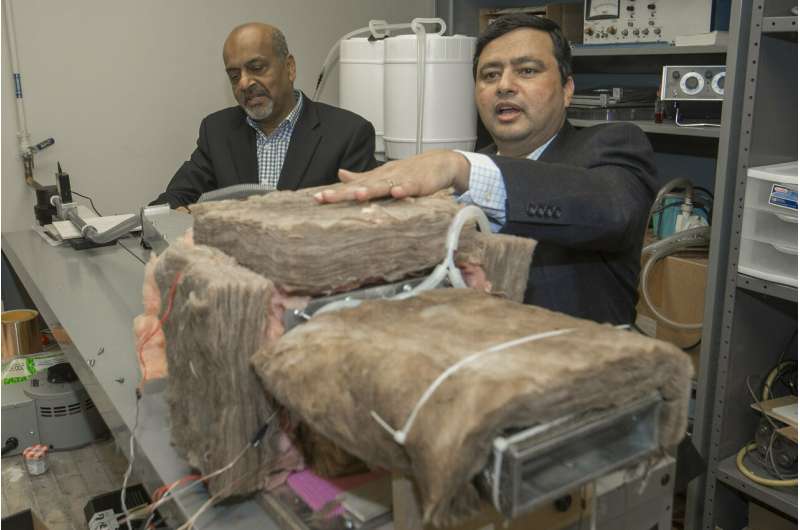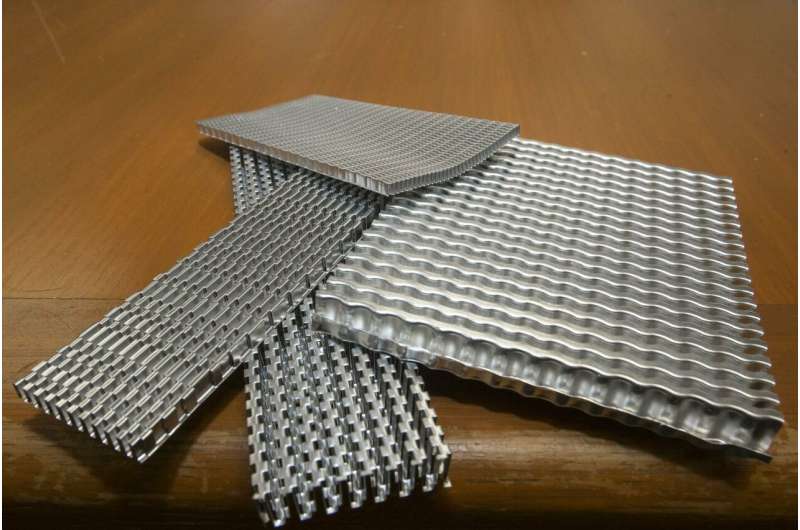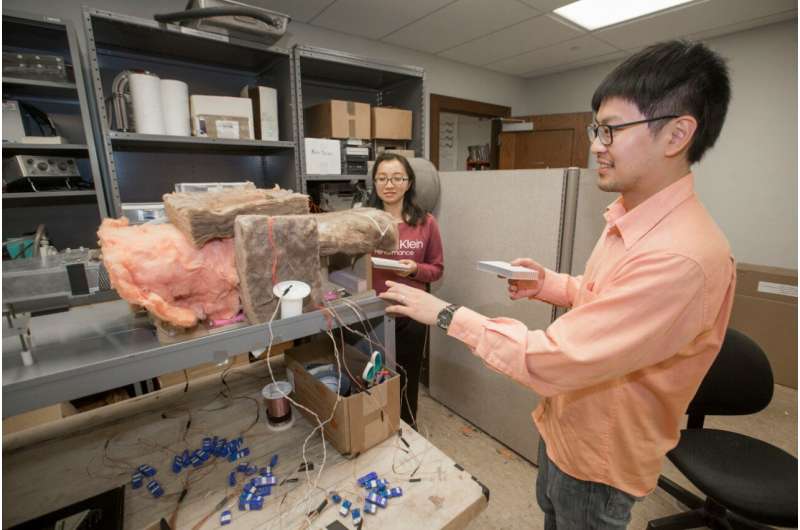University of Cincinnati professors Raj Manglik, left, and Milind Jog have developed an improved cooling system for power plants. Credit: Joseph Fuqua II/UC Creative Services
University of Cincinnati researchers say they have found a solution to one of the biggest environmental problems facing the energy industry: water consumption.
Power plants in the United States need as much water each year as all of the nation's farms combined—an estimated 133 billion gallons per day, according to federal numbers. This poses an enormous strain on water resources and has a detrimental environmental impact.
But Raj Manglik and Milind Jog, professors of mechanical engineering in UC's College of Engineering and Applied Science, say they have developed a new air-cooling system for power plants that uses no water but is nearly as effective as water-cooled systems.
"At some point this will be a water crisis—and it will be rather soon," Manglik said. "That was the primary motivation. Can we make air cooling significantly more viable so that companies would adopt it regardless?"??
The project was funded by a $3.4 million grant from the U.S. Department of Energy.
Most power plants in the United States are built alongside bodies of water to meet the demands of their cooling systems. Some water is lost through evaporation in cooling towers. In other cases, warmer water is pumped back into lakes, rivers or bays, which can raise the ambient temperature, killing fish and other aquatic organisms and creating toxic algae blooms. Scientists call this "thermal pollution."
The University of Cincinnati developed a better air-cooling system that could replace water systems in power plants. Credit: Margaret Weiner, Benjamin Gardner and Andrew Higley/UC Creative Services
"The water around power plants can be significantly warmer than the rest of a river or lake," Manglik said. "This adversely impacts fish and plants and destroys the ecosystem."
The two researchers used their backgrounds in experimental heat transfer, computational modeling and fluid dynamics to design a better air-cooled condenser for power plants. Like the radiator of a car, the condenser has a meshwork of metal fins specially designed by UC's researchers to draw heat away in the circulated air.
UC's researchers developed enhanced metal fins with a unique geometric design that favorably alters the air flow over them. This provides far better heat convection for cooling steam in the air-cooled condenser.
"The flow of air gets disrupted with more mixing and more efficient heat transfer compared to traditional fins used on these air-cooled condensers," Jog said.
Manglik said there was no single "Eureka!" moment but rather deliberate improvements over time.
"We use carefully controlled experimentation coupled with computational modeling," Manglik said. "Modeling helps us understand the physics. Experiments give us the results that can be used to optimize design."
UC engineers designed new condenser fins that shed heat more efficiently in power plants. Credit: Joseph Fuqua II/UC Creative Services
Shedding more heat increases the efficiency of the power plants, which means they can produce more electricity. And since the cooling system is more effective, it doesn't have to be as big and costly to build, they said. Laboratory scale tests suggested the researchers' system can reduce the cooling temperature from today's 140 degrees to as low as 115 degrees.
UC doctoral students Kuan-Ting Lin and Dantong Shi tested a small prototype in an engineering lab. Now UC is partnering with Taneytown, Maryland, company EVAPCO on a large-scale prototype test of the design at the company's labs.
But UC's engineers didn't stop with condenser fins. They also are working on a solution to one of the energy industry's biggest conundrums. In the summer, electricity demand typically peaks during the hottest part of the day when a plant's cooling systems are least efficient.
Professors Jog and Manglik are developing a better system to precool the circulated air using a heat sink that captures cooler temperatures at night.
"The second part we're developing is an air precooler coupled with thermal energy storage," Jog said. "So at night when the temperatures are low, the system 'stores' the cold. And that is used during the peak times to cool the air before it goes to the condenser."
UC's researchers also are working with Babcock & Wilcox, in Lancaster, Ohio, which in 2016 acquired the Italian company SPIG specializing in power plant cooling systems.
UC doctoral students Kuan-Ting Lin and Dantong Shi test a small prototype cooling system in an engineering lab. Photo/Joseph Fuqua II/UC Creative Services
Manglik said air-cooled power plants will become increasingly valuable in arid parts of the world in the face of growing industrialization and climate change.
"There is already a water shortage, exacerbated by the global need for energy," Manglik said. "We will need a substantially large number of new power plants if the rest of the world begins to consume energy at the rate we do in the United States."
The UC researchers have been working on patenting their ideas since submitting their grant proposal in 2015. Manglik said their results of the full-scale experiments will have to be persuasive.
"The inertia in engineering systems is mind-boggling. You go to an oil refinery or a petrochemical plant, and some of the technologies being used are 40 or 50 years old," Manglik said. "Efficiency is not always a measure that matters."
The two researchers have collaborated on diverse research projects at UC over the past decade.
"Dr. Jog has special talents in computational physics and modeling," Manglik said. "I add to that experimental insights. I don't mind getting my hands dirty—literally."
"I think that synergy makes it work," Jog said.
Provided by University of Cincinnati

























